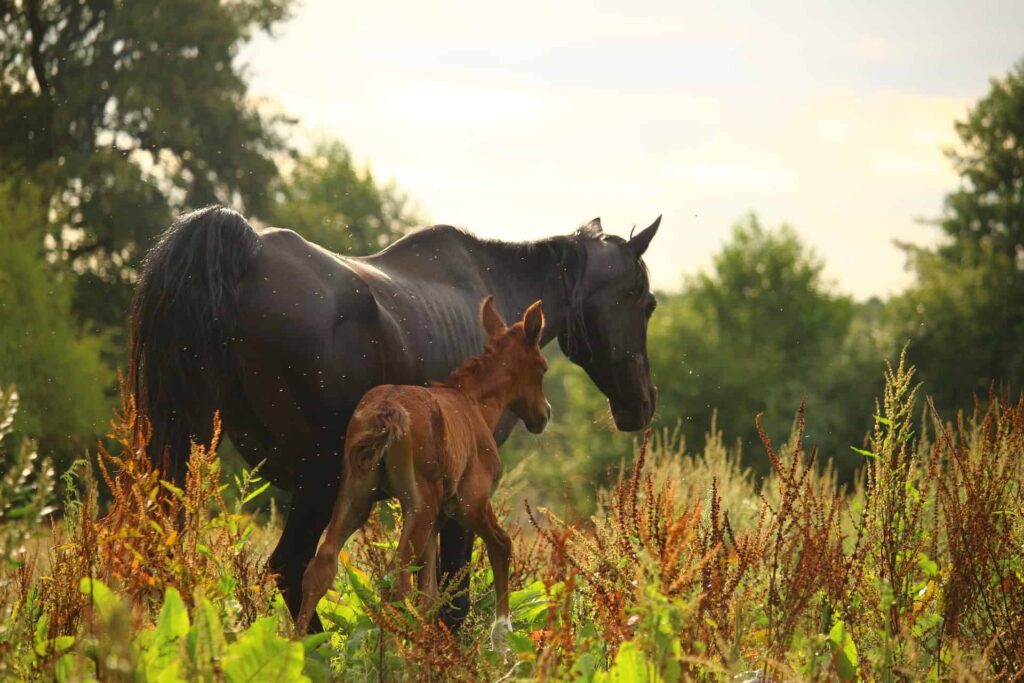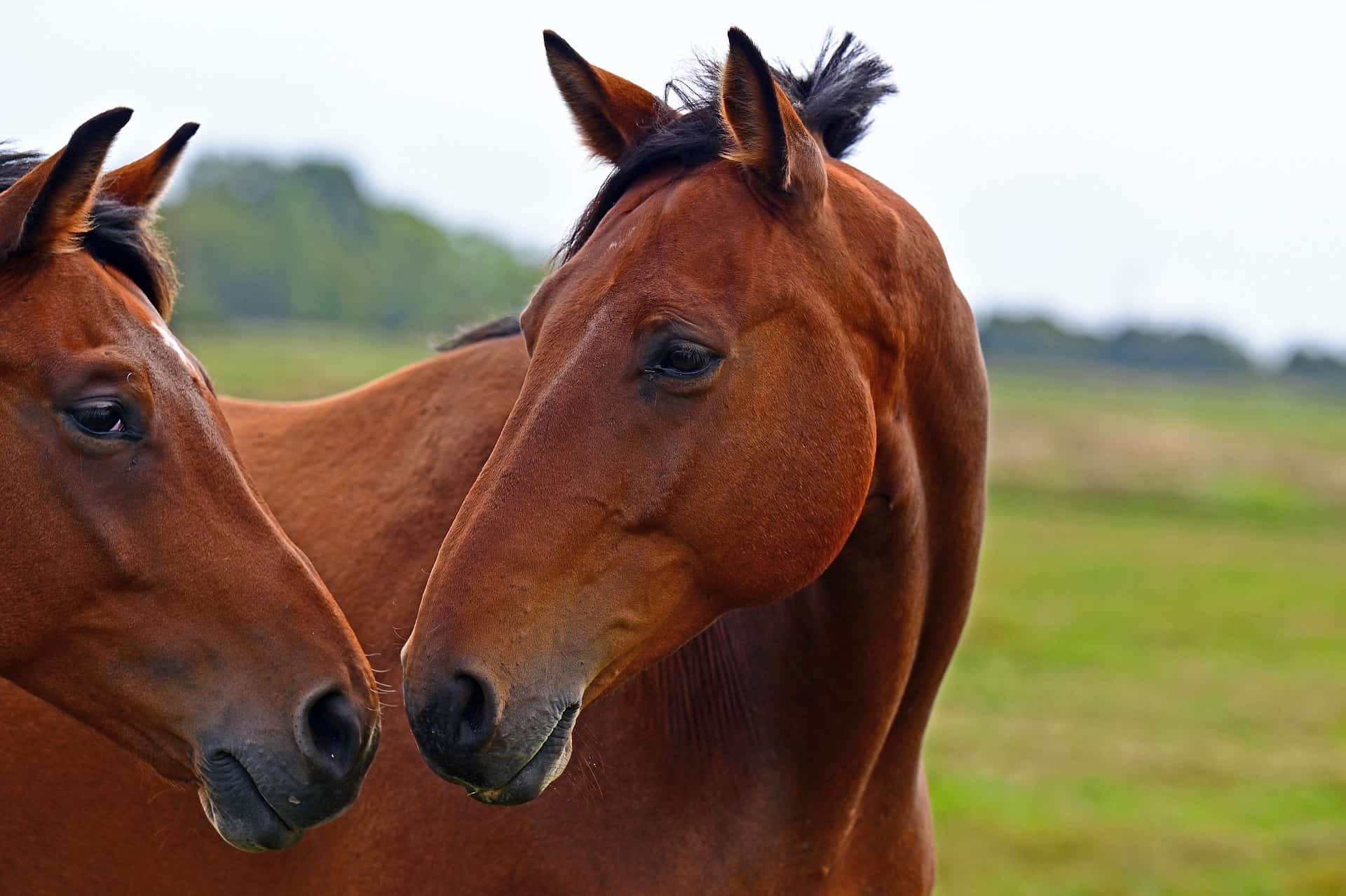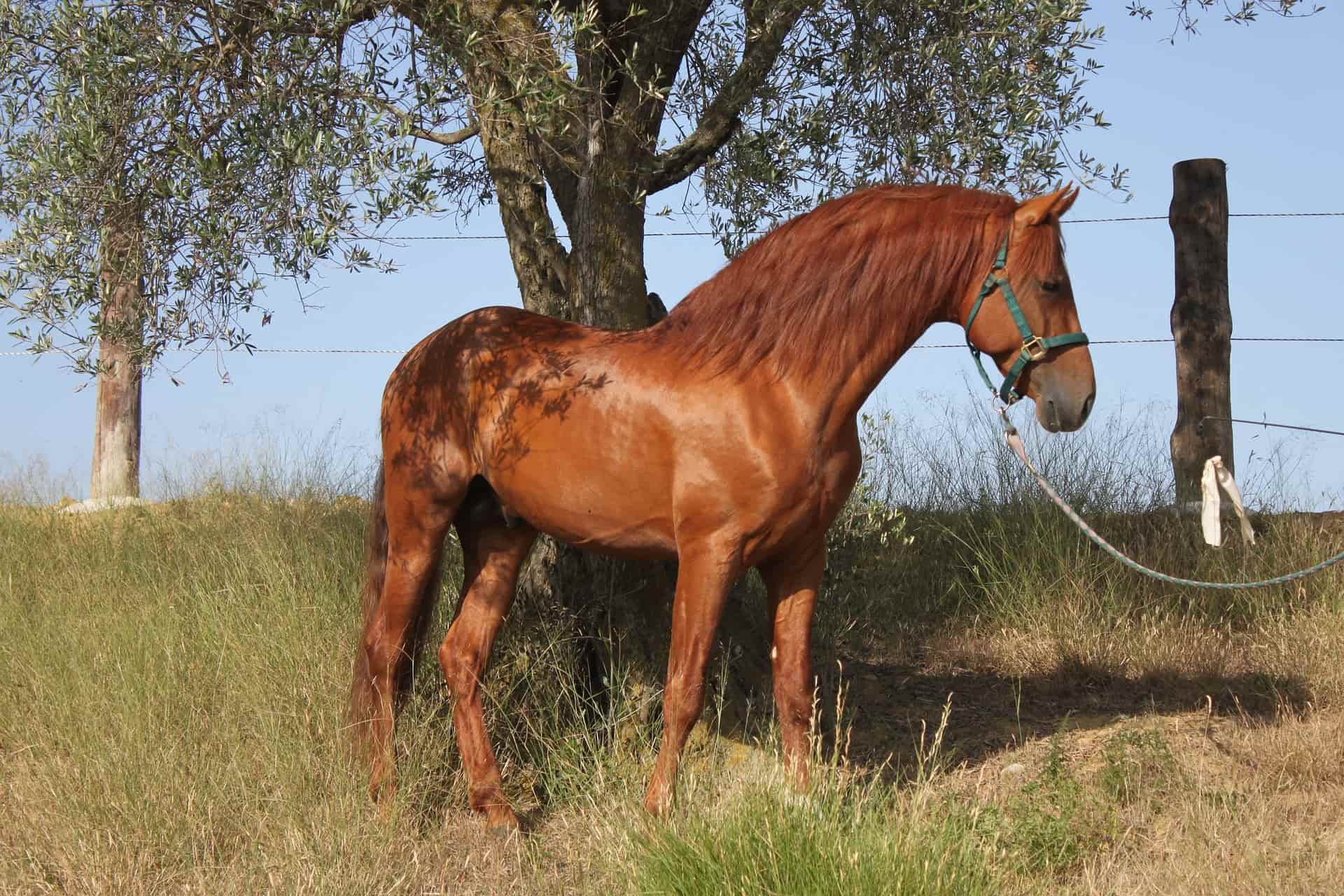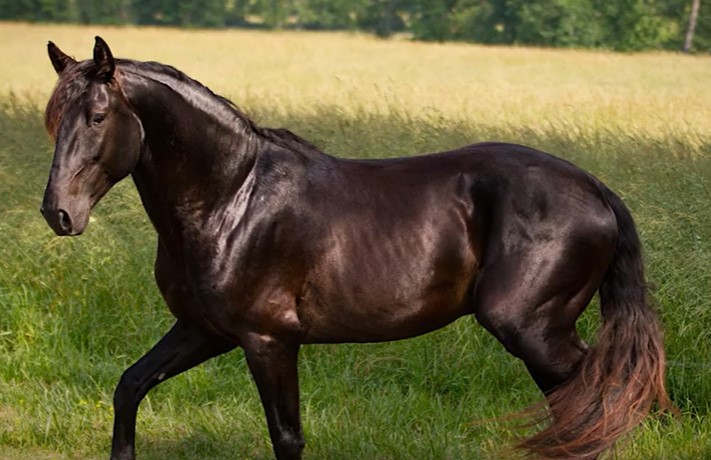Given their extensive use in horse racing, the thoroughbred is a well-known horse. Its speed, physique and excitable character continue to impress the masses that gather to watch these horses race.
The breed can trace its roots to the 17th and 18th centuries. It’s believed that thoroughbreds were created by crossing the Arabian, Turkoman and Barb stallions with native English mares. In the years that followed, the breed spread globally as more nations embraced the sport of horse racing.
Today, the Thoroughbred horse is ranked one of the most versatile breeds; taking part in almost every activity be it show jumping, fox hunting or polo. If you want to learn more about it, here are 16 fascinating Thoroughbred horse facts.
Interesting Facts About Thoroughbred Horses
1. Thoroughbreds have three foundation sires
If you encounter any purebred Thoroughbred horse, it likely came from one of three foundation stallions brought to England between the 17th and 18th centuries.
The three stallions were the Godolphin Arabian (popularly referred to as Godolphin Barb), the Darley Arabian and the Byerly Turk.
Among all three stallions, the Darley Arabian had the most significant impact on this breed’s development. Richard Darley received this horse as a gift from his sibling whilst working in Syria as a merchant.
A study carried out in 2005 by Trinity College researchers revealed that up to 95% of male Thoroughbreds can trace their roots to the Darley Arabian.
One other intriguing fact about this breed is that all the foundation mares were owned by English kings. Dubbed the ‘royal mares’, they belonged to James I (1603 to 1625) and Charles I (1625 to 1649).
2. A thoroughbred was ranked the most expensive horse
Of all equestrian sports, horse racing is undoubtedly the most lucrative one. The horses that go on to win prestigious races earn their owners millions of money.
The best thing about this is that after a horse has had a successful racing career, it continues to be valuable as a breeding animal. Essentially, racing thoroughbreds never stop being useful. It is no wonder a retired thoroughbred racehorse can sell for an exorbitant price.
On that note, of all horse breeds, a thoroughbred stallion known as Fusaichi Pegasus is ranked as the most expensive horse. It’s revered for winning the 2000 Kentucky Derby after which it was sold for a staggering $70 million to the Irish Coolmore Stud.
Pegasus was born on 2nd of April, 1997. Though it was a successful racehorse, it wasn’t very good as a breeding animal. Just 3 of its offspring thrived in Grade 1 races.
However, one of its descendants called Ruler on Ice was crowned the winner of the prominent Belmont Stakes. Belmont Stakes is a classic horse racing event that takes place in Belmont Park, New York.
3. Thoroughbreds influenced the development of many breeds
Were you aware that other horse breeds have thoroughbred blood coursing through their veins? Popular breeds like the Quarter Horse, American Standardbred and perhaps the Morgan can all trace their roots to thoroughbreds.
In fact, there are several Thoroughbred crosses that resulted in distinct horse breeds. Examples include:
- Anglo-Arab – this horse breed comes from cross between a Thoroughbred and Arabian
- Irish Sporthorse – stems from crossing a Thoroughbred and Irish Draft
- Appendix – comes from a cross between a Quarter horse and Thoroughbred
- American Paint Horse – this horse breed has thoroughbred parentage with pinto coloring
Suggested Reading: The Most Popular Crossbreed Horses
The reason why a lot of breeders are fond of thoroughbreds is because of their athleticism. Besides, numerous studbooks don’t mind registering horses with Thoroughbred bloodlines.
Examples of such studbooks that embrace thoroughbred breeding include Dutch Warmblood, Danish Warmblood, Hanoverian and Westphalian (German breeds) registries.
4. A Thoroughbred is ranked the smartest horse in the world
Thoroughbreds may be known for their speed and athleticism, but they’re also very intelligent. A retired racehorse called Lukas won the title of the world’s smartest horse. This is after it was able to correctly pinpoint 19 numbers in 60 seconds!
5. A Thoroughbred holds the high-jump world record
Intelligence isn’t the only thing that thoroughbred horses are known for. Turns out that thoroughbreds are also excellent high-jumpers.
Specifically, a chestnut thoroughbred known as Huaso broke the high jump world record in 1949. The horse jumped an impressive distance of 8 ft. 1.25 in. over an obstacle. It was being ridden by Captain Alberto Larraguibel.
Recommended Read: The Best Dressage Horse Breeds
6. Thoroughbreds come in other colors apart from gray and brown
A common misconception in the horse industry is that Thoroughbreds only come in either a gray or brown color. But this isn’t completely accurate.
Based on records from the Jockey Club in the U.S. 90% of all registered thoroughbreds come in a variation of gray/roan (although they do not posses the roan gene) or brown (chestnut, bay or dark bay).
However, it’s not unusual to encounter this breed in black or white. That said, white Thoroughbreds are extremely rare.

7. The fastest thoroughbred clocked in a speed of 43.97 mph
Back in 2008, a 2-year-old thoroughbred filly named Winning Brew set the record by achieving the highest race speed of 43.97 mph.
This is pretty impressive considering the average speed of a horse is just 27 mph. The speed of thoroughbreds can be attributed to their long legs that help them make long strides.
Nonetheless, thoroughbreds aren’t the fastest horse breeds. The crown for this goes to Quarter horses, which achieve top speeds; especially on short-distance runs.
In 2005, Long Goodbye – a quarter horse ran at a speed of 55 mph. This turned out to be the fastest speed achieved by this majestic animal.
8. 1st January is considered the birthday of racing thoroughbreds
Did you know that thoroughbreds born in the Northern hemisphere all share the same birthday every 1st of January?
So regardless of the month or day the horse was born, it automatically turns one year older at the beginning of the year. This tradition has been in existence for nearly two centuries.
Unfortunately, this means that horses born later on in the year are always at a disadvantage when participating in equestrian sports. If they end up competing with older horses, they have a higher chance of losing.
In the years preceding 1858, 1st May was considered the official birthday of all Thoroughbreds. This is because it corresponded to the beginning of the racing season. But Britain made the decision to postpone this date to 1st January. As such, this became the new birthday worldwide.
Interestingly, the Southern hemisphere follows a different tradition. For horses born in the southern hemisphere, their birthday is celebrated every 1st August.
9. Thoroughbred horses are one of the most famous horses globally
Another fact you should know about thoroughbred horses is that they’re among the most popular horse breeds in the world.
The popularity of this breed grew parallel to that of horse racing. Specifically, using thoroughbreds for this sport is a tradition that started in England. And as the fame of this equestrian sport grew, so did more breeds export Thoroughbred horses to other parts of the world.
Currently, thoroughbred racing is popular not only in England but also in the U.S., Australian, Japan, Ireland, New Zealand, India and Saudi Arabia.
The Thoroughbred is also considered one of the best barrel racing horse breeds.
10. The thoroughbred horse is hot-blooded
Technically, all horses- regardless of the breed – are warm-blooded mammals. But in the horse world, the phrases “warm-blood”, “cold-blood” and “hot-blood” are used loosely to refer to the breed’s temperament and kind.
The hot-blooded breeds are high-spirited and sometimes very anxious. Conversely, cold-blooded breeds are rational and more docile.
This doesn’t necessarily mean that every thoroughbred horse gets spooked easily. However, the majority need a bit of patience, especially when training.
11. Thoroughbreds start racing when they reach 2
The norm in the horse racing industry is to break a horse when it attains one year. Speaking of, the scientific name for foals that have not yet reached 1 year is a weanling. These horses then become eligible for racing when they reach two years old.
That said, racing young horses has always been a sensitive issue in the equestrian world. This is because a horse’s back isn’t well-developed by that age. In fact, it’s not until the horse celebrates its 5th or 6th birthday that its back matures properly.
Racehorse trainers, on their part, allege that Thoroughbreds mature faster than other breeds. So it’s not unusual to see a 2-year-old Thoroughbred racing.
Learn: When Does a Horse Stop Growing?
12. Thoroughbred horses are highly adoptable
As we mentioned in the beginning, Thoroughbreds are extremely versatile horses. In fact, there are several organizations committed to helping these horses transition to other careers after racing.
These horses that retire from racing are known as “off-the-track-thoroughbreds.” These horses make really great partners. However, they should be treated gently so they can get used to a life outside the racetrack.

13. No two thoroughbred racehorses share the same name
Finding the perfect name for a Thoroughbred racing horse is a tall order. This is because every horse is required to have a unique name, and one that’s been approved by the Jockey Club.
Even if you find one that’s unique, the Jockey Club still has about 17 naming requirements that you have to meet. If you resort to any made-up names, then you have to explain their meanings.
The Jockey Club also expects you to know the translation for any foreign names. Thankfully, you’re allowed to submit at least six names for review.
14. The Breeder’s Cup is considered the largest race in this breed’s industry
If you want your Thoroughbred to participate in the largest horse racing event, The Breeder’s Cup World Championships is it.
The Breeders’ Cup Limited has been organizing this prestigious race since 1984. It involves 14 Grade I races that take place over a period of two days.
The Breeder’s Cup is the most coveted event not only for jockeys but also trainers and horse owners. This is not surprising considering the amount of prize money at stake. In fact, the total prize money adds up to a staggering $31 million. The highest prize money that can be won by one winner is $6 million.
15. Thoroughbreds are prone to certain health issues
Like other horses, the Thoroughbred horse is vulnerable to a few health issues. The most common ones relate to their hooves. This is because the size of their feet is smaller relative to their bodies. This makes the Thoroughbred breed susceptible to lameness and soreness in their hooves.
Many thoroughbreds, especially those used as trail riding horses, also suffer from exercise induced pulmonary hemorrhage. This is bleeding that occurs in their lungs, and stems from very strenuous exercising.
There are two things that tend to exacerbate these conditions. One is the increased rate of inbreeding among horses in the thoroughbred breed family. And the second factor is selective breeding, which is done to improve a horse’s speed.
Still, most Thoroughbreds live a healthy and long life of between 25 and 30 years.
16. Some racing Thoroughbreds have big hearts
Thoroughbred horses may be vulnerable to a few health problems, but they also have some of the biggest hearts and lungs. Thanks to this, they’re able to withstand high-intensity training – a factor that gives them an edge in the equestrian sporting world.
As an example, one racing Thoroughbred had a heart that weighed about 22 pounds. Another Australian racing star known as Phar Lap had a heart that weighed 14 pounds (6.35kgs).
Conclusion
Thoroughbreds have some very noticeable physical traits. For instance, they have a well-chiseled head, a long neck, short back, broad chest and slender legs.
Physical appearance aside, this breed has some very intriguing facts. One of the most interesting thoroughbred horse facts is that they had three founding stallions.
These were the Godolphin Arabian, the Byerly Turk and the Darley Arabian, which had the most significant impact. When it comes down to the specific breed, Thoroughbreds can trace their origins to the Turkoman, Arabian and Barb horses.
Racing thoroughbreds have also broken world records, and they’re very hard to name. The naming of these horses is regulated by the Jockey Club. On a more positive note, Thoroughbreds live longer than other breeds.




